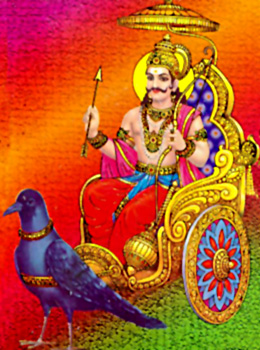 Legend of Shani is linked with the birth of Lord Ganesha. When Ganesha, the eldest son of the Mother of the Universe, was born, his cradle was visited by all the gods and demi-gods. There was only one exception and that was Shani, who did not come. When the mother of Ganesha noticed the absence of Shani, she inquired the reason of his absence. She was told that he feared to harm her child, since there was a common belief that the head of one on whom Shani looked was likely to be burned to ashes at his glance. With easy pride the mother smiled, and assuring him that her son could not be subject to his power, sent him a message of warm invitation and welcome. Thus, Shani came after being invited once again to see Ganesha but what was the horror of all present when he looked at the babe, and instantly its head disappeared in a flame. Thus every body experienced the power of Shani.
Legend of Shani is linked with the birth of Lord Ganesha. When Ganesha, the eldest son of the Mother of the Universe, was born, his cradle was visited by all the gods and demi-gods. There was only one exception and that was Shani, who did not come. When the mother of Ganesha noticed the absence of Shani, she inquired the reason of his absence. She was told that he feared to harm her child, since there was a common belief that the head of one on whom Shani looked was likely to be burned to ashes at his glance. With easy pride the mother smiled, and assuring him that her son could not be subject to his power, sent him a message of warm invitation and welcome. Thus, Shani came after being invited once again to see Ganesha but what was the horror of all present when he looked at the babe, and instantly its head disappeared in a flame. Thus every body experienced the power of Shani.
When Parvati, the mother of Ganesha, saw her son`s head burned into ashes at the sight of Shani, she was profoundly disturbed, and commanded her guest somewhat sharply at once to restore the head of her child. To this, Shani smiled pleasantly, and pointed out that the head as such no longer existed and the same lay in ashes before them. Then the mother ordered to bring her the head of the first one he meets, and Shani had no option but to obey her instructions. The head of someone could be bought who would be found doing any guilt, and the emissary of Shani found no one inadvertently doing wrong, till suddenly he came upon an elephant sleeping with his head to the north. This trifling fault brought him under the jurisdiction, and the servant hastily cut off his head and returned to put it on the body of the infant. It is thus believed that for this reason Lord Ganesha wears an elephant-head.
This legend of Shani gives an indication of the great power of Shani as well as the faith with which Shani is thus connected, the tree on which the new belief is grafted, the worship of Ganesha, are perhaps the oldest of organized and popular worships in India. It is also appealing to see that the very point in the image of Ganesha that is so anomalous and tantalizing to us was held likewise inexplicable at the time of the incoming Saturn and the other planets. Long, long ago had the worship of the gentle Ganesha gone out to the nations of the farther East, and now the fear of Shani was added to it in the land of its birth from foreign sources.




















